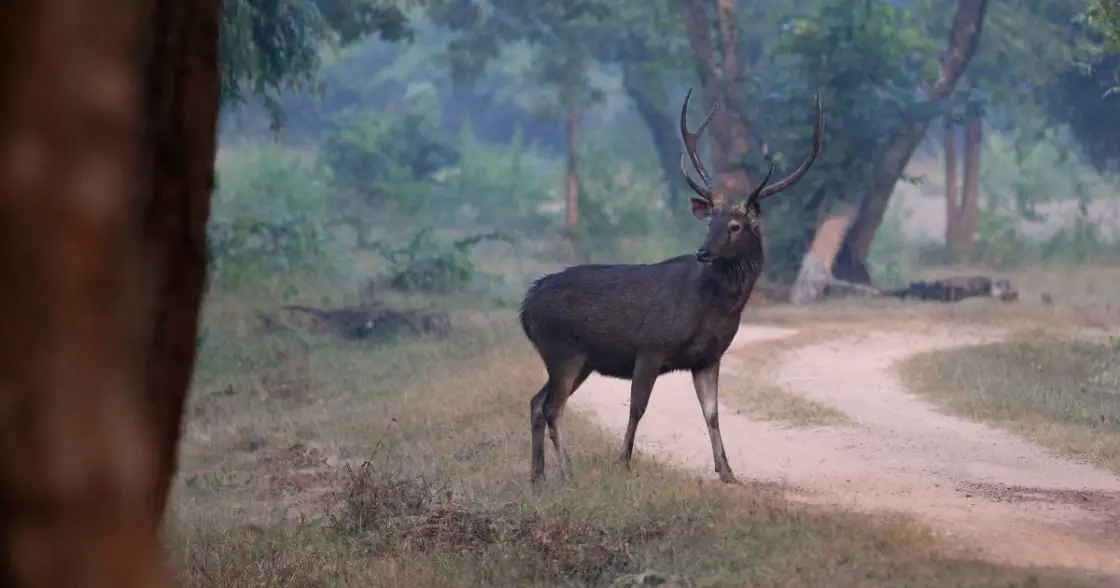The Indian Sambar Deer (Rusa unicolor) is an impressive deer which is native to India, South China, and Souteastern Asia. Its impressive size and unique coloring make it a target for hunting. It is a vulnerable species since 2008.
On this page I’ll share facts and information about the Indian Sambar deer including its size, appearance, range and habitat, unique behavior and reproductive habits.
Indian Sambar Deer Size & Measurements
- Head-Body Length – 170-270 cm
- Shoulder height – 120-150 cm
- Tail length – 22-35 cm
- Weight – 150-300 kg
What Does the Indian Sambar Deer Look Like?
The Indian Sambar is a strongly built and large species of deer. Males are larger than the females. The coat is long and thick, and in color it is a dark brown.
Males have a thick mane of hair around the neck. The antlers are especially impressive, reaching a length of in excess of 90 cm; and individual stags with antlers larger than 140 cm in length have been reported.
The Indian Sambar deer’s antlers have 6 tines, and are strongly pearled. The eye tine is well developed, as it is in the Philippine Sambar. The tines from the backwards-pointing branch of the antlers are considerable smaller than the forwards pointing tines.
The Indian Sambar has large eye glands, which enhance the impressive appearance of its head.
Habitat of the Indian Sambar
You will find the Indian Sambar in damp woodland environments. It favors locations near to marshes and woodland swamps.
When the antlers are in the velvet stage of their growth, the Sambar moves into more open habitats such as woodland glades and clearings.
You’ll find these deer at altitudes as high as 3,000 metres.
Where Does the Indian Sambar Deer Live?
The Sambar is one of the world’s most widely distributed types of deer. You may encounter various Sambar species throughout Asia.
The Indian Sambar is found throughout India and the Indian subcontinent.
Larger individuals occur in central India, and the deer that live closer to the coast tend to be smaller in size.
How Long Do Indian Sambar Deer Live?
This unique deer will typically live 16 and 20 years.
Unique Behavior
Sambar are more solitary in their ways than other species of deer, mostly living alone, or in only very small groups.
Sambar are mostly nocturnal in their habits, and they have very well developed senses. This allows them to easily detect predators.
When alarmed the Indian Sambar emit a repetitive honking alarm call. When fleeing they raise their tails so that the white underside is clearly visible.
Sambar have a number of predators, including the tiger. They are one of the favorite prey animals of the tiger.
Indian Sambar Deer eat leaves and various species of grasses.
Reproduction in the Sambar Deer
The rut takes place between October and November in most parts of India. The exact timing of the rut and birth of young depends on the location the deer lives in.
Males establish territories, which they defend from rivals. They pair up with females who visit their territory.
During the rut the males have a loud bellowing rutting call, which is quite distinctive.
The gestation period is long at about 8 months. When the deer carries its young to term, a single unspotted calf is born.
The newly born calf remains hidden in thick vegetation at first. This lasts the first few days of its life. The mother visits occasionally, nursing its calf.
Later, it begins to accompany the mother when she goes to feed. The young Indian Sambar deer calves are weaned at about 7 months of age, and become fully independent at about a year of age.


